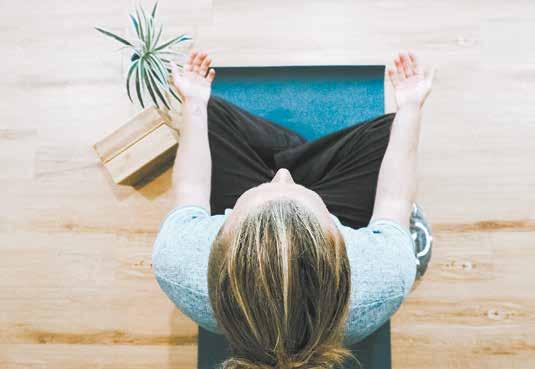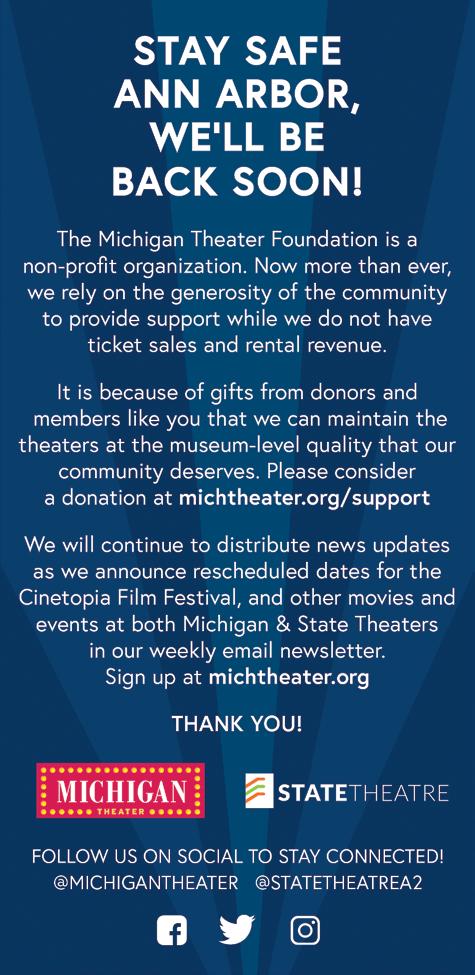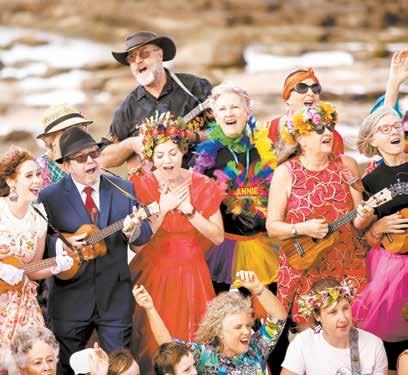
8 minute read
REINVENT THE
REINVENT THE HOLIDAYS More Meaning, Less Stuff
by Ronica O’Hara
Thomas F Kabisch, DO, MDh – drkabisch.com –Awoon PLLC • Metro Ann Arbor • 734-971-5483 2350 E Stadium Blvd Suite 12
INTEGRATED GENERAL MEDICINE for the whole family.

46 years experience with guarantees –don’t waste money.

n Stem Cell Therapy n Complementary Cancer & Intravenous Therapy n Addiction Therapy n Age Management n ‘Simple Life’ Cancer
Prevention Program
n Homeopathy n Herbology n Nutriceuticals n Pharmaceuticals n Neuropsychology n Manual & Energetic
Medicines
Certified Health Education Courses See curriculum online, visit drkabisch.com now.
Like many parents, Alicia Hough, a corporate wellness expert in New York, used to go overboard plying her kids with gifts at Christmas. “I was always busy with work, which is why I thought that buying my children the latest or most trending toy in the market will make up for the time I’ve lost,” she recalls. “As kids, they indeed get excited with material gifts, but that joy is just temporary, and that’s what I realized throughout this pandemic. In the end, it’s the relationship with people you value that matters, and not these material things or celebrations.”
Hough, who considers the pandemic a turning point, is not alone. In this turbulent year, holiday celebrations will likely be smaller, quieter and less opulent for many families. Yet the crisis has also set the stage for families “to create a holiday that is more in keeping with their values, finding deeper connection and meaning with less rushing around and spending less money,” says Laura Markham, a clinical psychologist and author of Peaceful Parent, Happy Kids.
Besides passing up traveling and parties for cozy pajama times, many families are seriously rethinking their gift-giving habits. Although presents are a beloved part of Christmas, Hanukkah and Kwanzaa celebrations, many families have come to wonder how the shopping and spending has gotten so out of hand. According to Investopedia, in 2019, the average American

spent $942 on holiday gifts, a figure that has steadily mounted in the last decade to total $1 trillion. An estimated $16 billion worth of those gifts are unappreciated and tossed aside, reports Moneyish.
This pandemic season offers “a chance to reset expectations if festive gift-giving has become excessive in recent years,” says Beth Kempton, author of Calm Christmas and a Happy New Year: A Little Book of Festive Joy. “Perhaps most important is to have a conversation with children about buying less stuff and avoiding waste,” she adds. “They may have their own ideas about how to reduce waste and relish the challenge of thinking about what they really want.”
Getting Creative
For Evan Porter, of Milton, Georgia, a parenting writer at DadFixesEverything.com, “Less clutter and fewer gifts are something we’ve been working toward anyway.” This year, he and his wife plan to drastically pare down their kids’ gifts, possibly using this formula: “Something to read, something to wear, something you want and something you need.” Instead of presents under a tree, Dawna Campbell, of Bigfork, Montana, founder of ThetaHeartHealing. com, will give her kids an unplugged (and coronavirus-compliant) nature retreat where they can investigate the natural environment, work with animals and journal about how to make the world a
better place.
For parents that want to embrace creativity, low costs and sustainability this holiday season, Kempton suggests the following gift-giving ideas:
n Build anticipation with a treasure hunt or by opening presents over a period of time. n Incorporate a sense of wonderment with a wooden magic set or a storybook written by either or both parents that stars the child. n Surprise the children by transforming a room in the house into a winter wonderland or turning the garden shed into Santa’s grotto. n Offer a parent’s time, skills and attention in the form of promissory notes or a small token that indicates a future shared experience, such as a jar of homemade marshmallows tied with a label promising a family camping trip. n Give children items that they can use or eat that are handmade by the parents. n Invoke a sense of nostalgia that prompts family storytelling, such as a jigsaw that summons memories of putting together a puzzle with a grandfather 50 years ago. n Celebrate environmental stewardship by planting and growing a Christmas tree or Hanukkah bush.
Even gift wrapping can become a fun and eco-smart family game by challenging everyone to creatively repurpose everything from old maps and fabrics to magazines and paper bags, perhaps decorated with artwork and nature finds. If every American family wrapped just three presents in re-used materials, it would save enough paper to cover 45,000 football fields, estimates the Centers for Disease Control and Prevention.
However they are wrapped, gifts demonstrate in these unprecedented times that deep joy comes not from acquiring new stuff, but from caring for and giving to each other—especially our children. “In the end, the most precious gift parents can give their children this holiday is their attention, infused with a little bit of festive magic,” says Kempton.
Ronica O’Hara, a Denver-based health writer, can be reached at OHaraRonica@ gmail.com.


Mind-Body Fitness How Mindfulness Benefits Workouts
by Marlaina Donato
When mindfulness approaches Research shows that mindfulness training are applied to fitness train- can also significantly raise self-esteem, and ing—which can be as simple as women that cultivate meditative self-combreathing consciously and tuning into subtle passion experience a boost in acceptance of body sensations—the results can be fewer and satisfaction with their bodies. injuries, improved immunity, a lowered “In nature, the bigger the eye of the storm, stress response, a brighter mood and a deep- the more powerful the winds, suggesting er commitment to staying fit. Being in the that our workout potential and enjoyment present moment can also spark enjoyment. is dependent not on how hard we push, but how calm and self-aware we can be,” says John Douillard, DC, author of Body, Mind, and Sport and the founder of LifeSpa, in Boulder, Colorado. “Slowing down and being aware of the body allows the mind to attend to muscles, which can increase blood supply, lymph drainage and replace a potentially damaging fight-or-flight response during a workout with a rejuvenating parasympathetic response.”
Tapping into Contentment
Mindful fitness instructor Ellen Barrett, in Washington Depot, Connecticut, offers clients a full-body experience with a fusion of movement forms and weight training. “We think mindfulness is some sort of yoga thing, but everything can become mindful. Jumping jacks and biceps curls can be mindful. It’s not the movement, but the awareness behind the movement. Mindfulness is about being present.”
Adding in balance training, tai chi and Pilates, and swapping a bit less time on the treadmill for a few moments of meditation or visualizing positive results can go a long way, say fitness experts. Debbie Rosas, founder and co-creator of Nia—a body-mind conditioning program anchored in martial arts and modern dance—underscores the importance of listening to cues. “Notice any areas that feel tight, blocked, rigid and bound. This wisdom through felt sense and awareness will immediately alert you to stop, adjust and slow down.”

The Portland-based co-author of The Nia Technique points to the fun factor. “I believe that when you stop exercising and start moving, anything you do can bring you enjoyment. Do things that leave you feeling successful and motivated to do them again.”
Breath as a Compass
Practicing conscious breathing fortifies the positive impact of exercise and can prevent injuries like hernias that can arise when the breath is held during heavy lifting. “One of the most powerful tools for mindfulness during a workout is following your breath. Mindfulness is the key, but it’s hard to be mindful when you’re breathing 26,000 times a day into the upper chest, activating a fightor-flight response,” says Douillard.
Breathing through the nose instead of the mouth during exercise bolsters mindfulness, and as Douillard has demonstrated in studies, causes brain waves to shift from stressed beta waves to a meditative alpha state. “It takes longer to fully inhale and exhale during nose breathing, which creates a baseline of calm,” she says. “Don’t rush. Be aware of the body breathing and feel each muscle contracting and relaxing with each rep and stretch.”
Chicago-based fitness expert Stephanie Mansour, host of the PBS weekly Step it Up with Steph show, concurs. “Sync your breath with your movement. Mindfully transition from exercise to exercise.” Mansour also suggests working out next to a mirror to improve alignment and avoiding the distraction that can come with having a workout buddy. “Another trick to improve form is to put on headphones and zone out by listening to white noise so that you have no distraction,” she says.
Exercising with deep body-presence is something we do for ourselves. “If you’re really paying attention, you can steer yourself towards invigoration and away from irritation. The body is always providing feedback, but we’re often too ‘out of body’ to notice. Giving full attention to your body is a big gift of self-love,” says Barrett.
“Breathe. Move. Be free,” adds Mansour. “This is your dedicated ‘me’ time and you can use it to feel good about yourself.”
Marlaina Donato is an author and composer. Connect at AutumnEmbersMusic.com.









